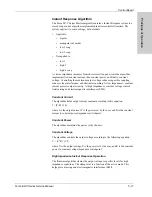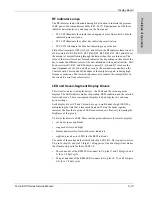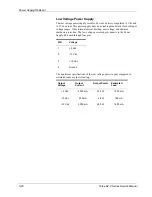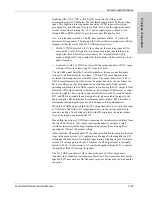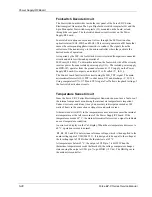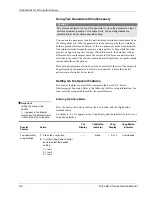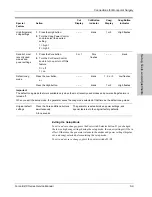
Power Supply/RF Board
5-22
Force EZ-C Series Service Manual
The current sense circuit, which uses current transformers T5 and T6, works the
same as the voltage sense circuit. T6 senses bipolar current and T5 senses
monopolar current. Relay K9 selects the appropriate current. Note that the current
scaling relays (K5–K7) switch at different power settings than the voltage scaling
relays.
Redundant Sense Circuits
The primary sense circuits are functionally in parallel to redundant sense circuits
for the dosage error monitoring function performed by the main microcontroller
on the Control board.
For redundant voltage sensing, a current sense transformer (T8) connects in series
with the capacitor ladder. A bridge rectifier (CR24, CR25, CR27, and CR28)
rectifies, divides, and limits this voltage before op-amp circuit U31A filters and
buffers it.
For redundant current sensing, another current sense transformer (T7) senses
current flow in both the bipolar output leads and the monopolar output leads. A
circuit identical to the redundant voltage sensing circuit follows for rectification,
division, limiting, buffering, and filtering.
The signals produced from the redundant sense circuits are scaled for zero to 5
Vdc operation for use by the analog-to-digital channels of the main
microcontroller on the Control board.
Output Relays
In all monopolar modes, K12 is closed and routes patient return current through
the REM receptacle. K10 routes active current through the single-pin (footswitch
activated) Accessory Instrument receptacle. K11 routes the active current through
the multipin (handswitch or footswitch activated) Monopolar Instrument
receptacle.
In bipolar mode, the REM receptacle relay is open. Relays K13 and K14 route
bipolar current to the Bipolar Instrument receptacle.
All output relays are open when the generator is not being activated.
Bipolar Mode
The bipolar mode circuit topology is essentially the same as the cut modes, except
the output voltage flows from C159 and the switching frequency is 470 kHz.
These differences allow the higher currents and lower voltages required in bipolar
surgery while still maintaining the advantages of zero voltage switching in the
MOSFET. The T_ON\ signal is a continuous pulse train.




